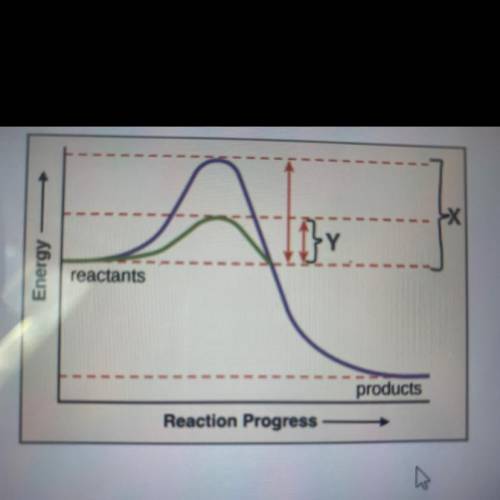
In the graph, which letter represents the activation energy of a reaction without an enzyme and why?
A. Y; the activation energy is greater in an uncatalyzed reaction
B. X; the activation energy is reduced in a catalyzed reaction
C. X; the activation energy is greater in an uncatalyzed reaction
D. Y; the activation energy is reduced in an uncatalyzed reaction


Answers: 2


Another question on Biology

Biology, 21.06.2019 20:00
Read the following scenario to answer the following question. over the past 60 years, many amphibian species have experienced significant population declines, and some species have become extinct. scientists suspected that local human activities such as the destruction of wetlands, regional pollution, and deforestation were the main reasons for these losses. however, research over the past 20 years reveals significant amphibian population declines in protected areas of the world, such as nature preserves and parks. these global declines suggest widespread problems including increased ultraviolet radiation, acid rain, and disease. in switzerland, for example, 14 of the 20 native amphibian species are threatened with extinction. when most populations of a wide-ranging amphibian species are lost and the few remaining populations are widely separated, we expect to see that a. the founder effect becomes increasingly important b. microevolution no longer occurs c. gene flow between populations is reduced d. artificial selection becomes a greater factor in microevolution
Answers: 2

Biology, 22.06.2019 03:00
Where does all the water go? according to the environmental protection agency (epa), in a typical wetland environment, 39% of the water is outflow; 46% is seepage; 7% evaporates; and 8% remains as water volume in the ecosystem (reference: united states environmental protection agency case studies report 832-r-93-005). chloride compounds as residuals from residential areas are a problem for wetlands. suppose that in a particular wetland environment the following concentrations (mg/l) of chloride compounds were found: outflow, 60.4; seepage, 73.7; remaining due to evaporation, 26.4; in the water volume, 46.8. (a) compute the weighted average of chlorine compound concentration (mg/l) for this ecological system. (round your answer to one decimal place.) mg/l (b) suppose the epa has established an average chlorine compound concentration target of no more than 58 mg/l. does this wetlands system meet the target standard for chlorine compound concentration? yes. the average chlorine compound concentration (mg/l) is too high. yes. the average chlorine compound concentration (mg/l) is lower than the target. no. the average chlorine compound concentration (mg/l) is lower than the target. no. the average chlorine compound concentration (mg/l) is too high.
Answers: 3

Biology, 22.06.2019 04:00
The nervous system interacts with the endocrine system by a. using hormones as connections b. sending nerve impulses directly to glands c. using neuroendocrine cells as connections d. sending neurotransmitters directly to neurons
Answers: 1

Biology, 22.06.2019 06:30
Amino acids contain the elements carbon, hydrogen, oxygen, nitrogen, and sometimes sulfur. of the 20 amino acids found in humans, 11 are called "nonessential" because they can be manufactured by the body when needed. which elements in these 11 amino acids are commonly obtained from the metabolism of sugar molecules?
Answers: 1
You know the right answer?
In the graph, which letter represents the activation energy of a reaction without an enzyme and why?...
Questions

Mathematics, 05.10.2019 03:30





Geography, 05.10.2019 03:30


History, 05.10.2019 03:30

Mathematics, 05.10.2019 03:30

Mathematics, 05.10.2019 03:30

Mathematics, 05.10.2019 03:30

Social Studies, 05.10.2019 03:30

Social Studies, 05.10.2019 03:30


Social Studies, 05.10.2019 03:30



Chemistry, 05.10.2019 03:30

History, 05.10.2019 03:30



